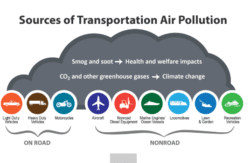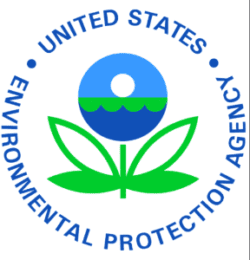Learn about pollutants from vehicles and engines that cause harmful health effects and climate change.
- What vehicles, engines and pollutants are regulated by EPA?
- Health and environmental impacts of air pollution
- Health and environmental impacts of climate change
What Vehicles, Engines and Pollutants are Regulated by EPA?
EPA emissions standards for vehicles and engines cover everything from weed whackers to locomotives.
Sources of air pollution cause smog, soot, health and welfare impacts.
Carbon dioxide (C02) and other greenhouse gases affect climate change.
Sources of air pollution are onroad vehicles and engines (light-duty vehicles, heavy duty vehicles, and motorcycles) and nonroad vehicles and engines (aircraft, nonroad diesel equipment, marine engines, ocean vessels, locomotives, lawn and garden equipment, recreation vehicles.
Solutions for transportation air pollution, emission reductions, can lead to cleaner air and better health.
Catalytic converters in conjunction with unleaded gasoline and low sulfur levels significantly reduce hydrocarbon and nitrogen oxide emissions
Fuel standards reduce exposure to pollutants like lead and benzene. Renewable fuels reduce CO2 emissions.
Engine technologies like computer controls, variable valve timing, multi-valve engines, turbo charging and gasoline direct injection improve fuel economy and reduce CO2 emissions.
Transmission technologies like 7+ speeds, dual clutch transmissions, (DCTs), and continuously variable transmissions (CVTs) improve fuel economy and reduce CO2 emissions.
Diesel filters reduce particulate matter from on road and off road diesel engines.
Alternative vehicle technologies like plug-in electric vehicles and fuel cells equals zero tailpipe emissions
Better transportation planning for passengers and freight reduce emissions and fuel use.
Health and Environmental Impacts of Air Pollution
Mobile sources of air pollution emit ozone, particle pollution, and air toxics. The health effects of mobile source air pollution affect millions of people, especially people who live near busy roads. The environmental impacts include haze in many parts of the U.S., including many of our national parks and wilderness areas, and the acidification of lakes and streams.
Health and Environmental Impacts of Climate Change
The impacts of climate change include warming temperatures, changes in precipitation, increases in the frequency or intensity of some extreme weather events, and rising sea levels. These impacts threaten our health by affecting the food we eat, the water we drink, the air we breathe, and the weather we experience.




